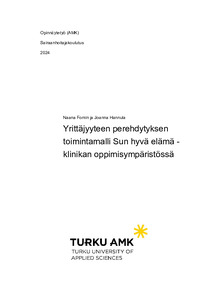Yrittäjyyteen perehdytyksen toimintamalli Sun hyvä elämä -klinikan oppimisympäristössä
Fomin, Naana; Hannula, Joanna (2024)
Fomin, Naana
Hannula, Joanna
2024
All rights reserved. This publication is copyrighted. You may download, display and print it for Your own personal use. Commercial use is prohibited.
Julkaisun pysyvä osoite on
https://urn.fi/URN:NBN:fi:amk-202404176837
https://urn.fi/URN:NBN:fi:amk-202404176837
Tiivistelmä
Opinnäytetyön tarkoituksena oli kartoittaa sairaanhoitajaopiskelijoiden kokemuksia yrittäjyyteen perehdytyksestä Turun ammattikorkeakoulun Sun hyvä elämä -klinikalla ja luoda perehdytysmalli Sun hyvä elämä -klinikan oppimisympäristöön. Opinnäytetyön tavoite on kehittää sairaanhoitajaopiskelijoiden perehdyttämistä yrittäjyyteen.
Opinnäytetyö toteutettiin kvalitatiivisena tutkimuksena. Opinnäytetyön aineistonkeruumenetelmänä käytettiin teemahaastattelua (n=14). Haastattelut toteutettiin ryhmähaastatteluna kahdelle, Sun hyvä elämä -klinikalla harjoittelussa olevalle sairaanhoitajaopiskelijaryhmälle. Haastatteluiden tuottama aineisto analysoitiin aineistolähtöisellä sisällönanalyysimenetelmällä.
Haastateltavien mukaan perehdytyksen tärkeimmät piirteet ovat suunnitelmallisuus, rauhallinen tahti, kattavat perehdytysmateriaalit, rooliinsa sitoutunut perehdyttäjä sekä opitun kertaaminen ja palautteen antaminen. Haastatteluiden perusteella yrittäjyyteen perehdytyksen haasteita ovat erityisesti teoriatiedon puute ja tiedonkulku opiskelijaryhmien välillä. Opinnäytetyössä kehitettiin perehdytysmalli, joka sisältää kuusi osiota: esittely, teoriatieto, työskentelyn aloitus, tiedonkulku, palaute ja kertaus sekä itsenäinen työskentely. The purpose of this thesis was to describe entrepreneurship orientation experiences of nursing students in the learning environment of Sun hyvä elämä -clinic at the Turku University of Applies Sciences and to create an orientation model for the learning environment of Sun hyvä elämä -clinic. The goal is to improve entrepreneurship orientation for nursing students.
The thesis is a qualitative study. Data collection method used in the thesis is thematic interview (n=14). The interviews were conducted as group interviews by two nursing student groups who were on a practical training period at Sun hyvä elämä -clinic. The material produced from the interviews was analysed using data-driven content analysis method.
According to the interviewees the most important characteristics of orientation are systematicity, calm pace, comprehensive orientation materials, a trainer who is committed to their role, revising learned topics, and providing feedback. Based on the interviews, the challenges in the entrepreneurship orientation are especially the lack of theoretical knowledge and the flow of information between the student groups. In the thesis, an orientation model was created, which includes six parts: Introduction, Theoretical knowledge, Commencement of work, Information flow, Feedback and revision, and Independent working.
Opinnäytetyö toteutettiin kvalitatiivisena tutkimuksena. Opinnäytetyön aineistonkeruumenetelmänä käytettiin teemahaastattelua (n=14). Haastattelut toteutettiin ryhmähaastatteluna kahdelle, Sun hyvä elämä -klinikalla harjoittelussa olevalle sairaanhoitajaopiskelijaryhmälle. Haastatteluiden tuottama aineisto analysoitiin aineistolähtöisellä sisällönanalyysimenetelmällä.
Haastateltavien mukaan perehdytyksen tärkeimmät piirteet ovat suunnitelmallisuus, rauhallinen tahti, kattavat perehdytysmateriaalit, rooliinsa sitoutunut perehdyttäjä sekä opitun kertaaminen ja palautteen antaminen. Haastatteluiden perusteella yrittäjyyteen perehdytyksen haasteita ovat erityisesti teoriatiedon puute ja tiedonkulku opiskelijaryhmien välillä. Opinnäytetyössä kehitettiin perehdytysmalli, joka sisältää kuusi osiota: esittely, teoriatieto, työskentelyn aloitus, tiedonkulku, palaute ja kertaus sekä itsenäinen työskentely.
The thesis is a qualitative study. Data collection method used in the thesis is thematic interview (n=14). The interviews were conducted as group interviews by two nursing student groups who were on a practical training period at Sun hyvä elämä -clinic. The material produced from the interviews was analysed using data-driven content analysis method.
According to the interviewees the most important characteristics of orientation are systematicity, calm pace, comprehensive orientation materials, a trainer who is committed to their role, revising learned topics, and providing feedback. Based on the interviews, the challenges in the entrepreneurship orientation are especially the lack of theoretical knowledge and the flow of information between the student groups. In the thesis, an orientation model was created, which includes six parts: Introduction, Theoretical knowledge, Commencement of work, Information flow, Feedback and revision, and Independent working.
